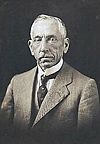- National Labor Party
-
For other parties of the same or similar name, see National Labour Party (disambiguation).
National Labor Party 
Leader Billy Hughes Founded 14 November 1916 Dissolved 17 February 1917 Preceded by pro-conscription Labor Succeeded by Nationalist Party of Australia Ideology Social democracy,
NationalismPolitical position Centre-left Politics of Australia
Political parties
ElectionsThe National Labor Party was the name used by the Australian Prime Minister Billy Hughes for himself and his followers after he was expelled from the Australian Labor Party in November 1916 over his pro-conscription stance in relation to World War I. Hughes had taken over as leader of the Labor Party and Prime Minister of Australia when anti-conscriptionist Andrew Fisher resigned.
On 15 September 1916 the executive of the Political Labour League (the Labor Party organisation in New South Wales at the time) expelled Hughes from the Labor Party. When the Federal Parliamentary Labor caucus met on 14 November 1916, lengthy discussions ensued until Hughes walked out with 24 other Labor members and the remaining (43) members of Caucus then passed their motion of no confidence in the leadership, effectively expelling Hughes and the other members.
Hughes and his followers formed a minority Government. Believing the Labor Party was no longer sufficiently nationalist, they began laying the groundwork for a new party that would be both socially radical and nationalist. However, they had to depend on support from the Commonwealth Liberal Party, led by another Labor dissident, Joseph Cook. In 1917, Hughes and Cook turned their confidence-and-supply agreement into a formal party, the Nationalist Party of Australia, with Hughes as leader.
The National Labor Party was never formally constituted a party and had no organisational structure, although some trade union officials and Labor Party branches, particularly in Western Australia and Tasmania, supported it.
Western Australia
The National Labor movement in Western Australia started off as two separate groups—one known as the Labor Solidarity Committee based out of Trades Hall in Perth, and the other known as National Labor and based on the goldfields. The two merged in April-May 1917, with former Premier John Scaddan as their leader. However, by July he was without a seat in Parliament, and the party turned to Federal Senators Patrick Lynch, Hugh de Largie and George Pearce for leadership and guidance. Unlike its federal counterpart, it maintained its own distinct identity and structure and worked with the Nationalists as coalition partners. A number of Western Australian unions disaffiliated from the Australian Labor Federation to support the National Labor movement—most notably those representing the engine-drivers, railway employees, boilermakers and carpenters which were powerful in the goldfields. Organisationally, however, the party was believed to be over-dependent on its Senate patrons and struggled to build a genuine extraparliamentary organisation.
The party scored six of 50 Assembly seats in each of the 1917 and 1921 elections, and held three of 30 Council seats during this period. However, in the 1924 elections, their representation was reduced to one in the Assembly and two in the Council—many through the defeat of sitting NLP members by Labor candidates—and later that year, what remained of the Party was subsumed by the Nationalists.
See also
- Politics of Australia
- Political parties in Australia
References
- Australian Dictionary of Biography - Billy Hughes
- Robertson, John R. (1958). The Scaddan government and the conscription crisis, 1911-17 : aspects of Western Australia's political history (thesis). University of Western Australia. Accessed in Scholars Centre, Reid Library, UWA.
- Cusack, Danny. (2002). With an olive branch and a shillelagh: The political career of Senator Paddy Lynch (1867-1944) (thesis). Murdoch University. Accessed via Murdoch Digital Theses.
Categories:- Australia political party stubs
- Labour parties
- Defunct political parties in Australia
- Political parties established in 1916
- Political parties disestablished in 1917
- Australian Labor Party breakaway groups
- 1916 establishments in Australia
Wikimedia Foundation. 2010.
